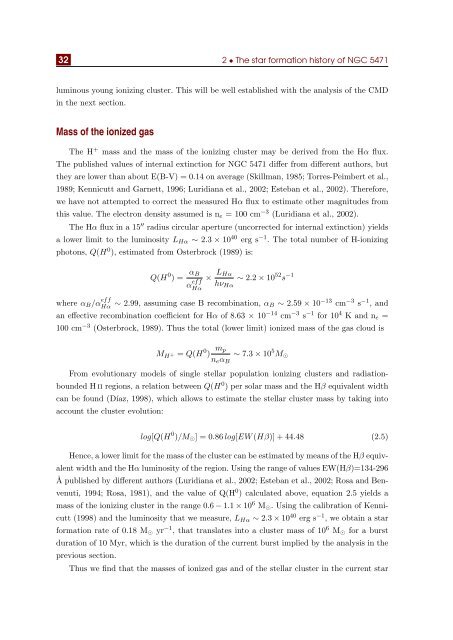A spatially resolved study of ionized regions in galaxies at different ...
A spatially resolved study of ionized regions in galaxies at different ...
A spatially resolved study of ionized regions in galaxies at different ...
You also want an ePaper? Increase the reach of your titles
YUMPU automatically turns print PDFs into web optimized ePapers that Google loves.
32 2 • The star form<strong>at</strong>ion history <strong>of</strong> NGC 5471<br />
lum<strong>in</strong>ous young ioniz<strong>in</strong>g cluster. This will be well established with the analysis <strong>of</strong> the CMD<br />
<strong>in</strong> the next section.<br />
Mass <strong>of</strong> the <strong>ionized</strong> gas<br />
The H + mass and the mass <strong>of</strong> the ioniz<strong>in</strong>g cluster may be derived from the Hα flux.<br />
The published values <strong>of</strong> <strong>in</strong>ternal ext<strong>in</strong>ction for NGC 5471 differ from <strong>different</strong> authors, but<br />
they are lower than about E(B-V) = 0.14 on average (Skillman, 1985; Torres-Peimbert et al.,<br />
1989; Kennicutt and Garnett, 1996; Luridiana et al., 2002; Esteban et al., 2002). Therefore,<br />
we have not <strong>at</strong>tempted to correct the measured Hα flux to estim<strong>at</strong>e other magnitudes from<br />
this value. The electron density assumed is n e = 100 cm −3 (Luridiana et al., 2002).<br />
The Hα flux <strong>in</strong> a 15 ′′ radius circular aperture (uncorrected for <strong>in</strong>ternal ext<strong>in</strong>ction) yields<br />
a lower limit to the lum<strong>in</strong>osity L Hα ∼ 2.3 × 10 40 erg s −1 . The total number <strong>of</strong> H-ioniz<strong>in</strong>g<br />
photons, Q(H 0 ), estim<strong>at</strong>ed from Osterbrock (1989) is:<br />
Q(H 0 ) = α B<br />
α eff<br />
Hα<br />
× L Hα<br />
hν Hα<br />
∼ 2.2 × 10 52 s −1<br />
where α B /α eff<br />
Hα ∼ 2.99, assum<strong>in</strong>g case B recomb<strong>in</strong><strong>at</strong>ion, α B ∼ 2.59 × 10 −13 cm −3 s −1 , and<br />
an effective recomb<strong>in</strong><strong>at</strong>ion coefficient for Hα <strong>of</strong> 8.63 × 10 −14 cm −3 s −1 for 10 4 K and n e =<br />
100 cm −3 (Osterbrock, 1989). Thus the total (lower limit) <strong>ionized</strong> mass <strong>of</strong> the gas cloud is<br />
M H + = Q(H 0 ) m p<br />
n e α B<br />
∼ 7.3 × 10 5 M ⊙<br />
From evolutionary models <strong>of</strong> s<strong>in</strong>gle stellar popul<strong>at</strong>ion ioniz<strong>in</strong>g clusters and radi<strong>at</strong>ionbounded<br />
H ii <strong>regions</strong>, a rel<strong>at</strong>ion between Q(H 0 ) per solar mass and the Hβ equivalent width<br />
can be found (Díaz, 1998), which allows to estim<strong>at</strong>e the stellar cluster mass by tak<strong>in</strong>g <strong>in</strong>to<br />
account the cluster evolution:<br />
log[Q(H 0 )/M ⊙ ] = 0.86 log[EW (Hβ)] + 44.48 (2.5)<br />
Hence, a lower limit for the mass <strong>of</strong> the cluster can be estim<strong>at</strong>ed by means <strong>of</strong> the Hβ equivalent<br />
width and the Hα lum<strong>in</strong>osity <strong>of</strong> the region. Us<strong>in</strong>g the range <strong>of</strong> values EW(Hβ)=134-296<br />
Å published by <strong>different</strong> authors (Luridiana et al., 2002; Esteban et al., 2002; Rosa and Benvenuti,<br />
1994; Rosa, 1981), and the value <strong>of</strong> Q(H 0 ) calcul<strong>at</strong>ed above, equ<strong>at</strong>ion 2.5 yields a<br />
mass <strong>of</strong> the ioniz<strong>in</strong>g cluster <strong>in</strong> the range 0.6 − 1.1 × 10 6 M ⊙ . Us<strong>in</strong>g the calibr<strong>at</strong>ion <strong>of</strong> Kennicutt<br />
(1998) and the lum<strong>in</strong>osity th<strong>at</strong> we measure, L Hα ∼ 2.3 × 10 40 erg s −1 , we obta<strong>in</strong> a star<br />
form<strong>at</strong>ion r<strong>at</strong>e <strong>of</strong> 0.18 M ⊙ yr −1 , th<strong>at</strong> transl<strong>at</strong>es <strong>in</strong>to a cluster mass <strong>of</strong> 10 6 M ⊙ for a burst<br />
dur<strong>at</strong>ion <strong>of</strong> 10 Myr, which is the dur<strong>at</strong>ion <strong>of</strong> the current burst implied by the analysis <strong>in</strong> the<br />
previous section.<br />
Thus we f<strong>in</strong>d th<strong>at</strong> the masses <strong>of</strong> <strong>ionized</strong> gas and <strong>of</strong> the stellar cluster <strong>in</strong> the current star

















